Sun activity for May 31, 2023: Flares and prominences in the southwest
The southwest remains the focus of activity on our sun, producing prominences and exploding filaments. It appears that – after departing from the Earth-viewed sun on the southwest limb (edge) yesterday – sunspot AR3310 is continuing its recent uptick in activity from beyond the solar horizon. We saw a filament erupting from this area at 01:17 UTC on May 31. The southwest also saw the largest flare of the past day: an M1.4 from giant sunspot region AR3315 at 13:38 UTC on May 30. You can still see this sunspot from Earth, with the proper eye protection. Catch it before it rotates out of view in a few days! Get observing tips in the video below.
Last 24 hours: Sun activity remains at moderate, with two M flares and 14 C flares produced between 11 UTC yesterday and 11 UTC today. As mentioned above, the largest flare was an M1.4 from AR3315 at 13:38 UTC on May 30. It produced an R1 (minor) radio blackout over the Atlantic Ocean on the northwest coast of Africa. The second M flare of the period was an M1.3 by an as-yet-unnumbered active region in the southeast. It was fired at 4:38 UTC on May 31, producing an R1 (minor) blackout over Vietnam. We also saw a filament erupt on the northwest quadrant at 21:09 UTC on May 30. There is a newcomer sunspot region, AR3220, near the northeast limb (edge). There are currently nine sunspot regions on the Earth-facing side of our sun.
Sun activity for May 30, 2023: Gentle giant sunspot now active as it departs
Yes, AR3315 is the biggest active region on the sun now. Check out the video below with some tips on how to see it. But it’s not the only giant sunspot visible now. Gentle giant AR3310 is now departing over the sun’s southwest limb (edge). As it makes its exit from the sun’s Earth-facing side, it has become the lead flare producer of the past day. Note that AR3310 is made of a single sunspot, while the largest sunspot region, AR3315, is multiple spots. Plus AR3315 has lost its delta region (a classification indicating possible pending M and X flare production). But AR3315 remains the most magnetically complex region with a beta-gamma configuration. You might see departing region AR3310, and you can certainly see AR3315, from the ground! Magnification is not required, but the correct eye protection is. Wear eclipse or solar viewing glasses and give it a try! For a better view you can use solar binoculars (several people at EarthSky’s sun team use these).
Last 24 hours: As we say goodbye to AR3310, four new sunspots have arrived on our sun. AR3317 and AR3318 are on the northwest quadrant, and AR3319 emerged from seemingly nowhere just south of the central meridian. Plus, we can now see AR3320 on the southeast limb (edge). There are two new large coronal holes that adorn our sun today, too: one on the northeast quadrant, and a larger one on the southeast. This all suggests that action is coming our way. Two M flares in the past day have brought sun activity back to moderate. There were 16 flares produced between 11 UTC yesterday and 11 UTC today: 14 C flares, an M1.2, and an M1.3. Both Ms were from departing sunspot region AR3310. The M1.2 was fired at 07:45 UTC, and the slightly larger M1.3 at 10:15 UTC, both on May 30. Having long been a stable gentle giant, AR3110 became the lead producer with six flares. After the M flares, R1 (minor) radio blackouts affected areas over the Persian Gulf and Africa respectively. AR3315, the current largest and most complex region, only produced three C flares. The sun today has eight numbered active regions.
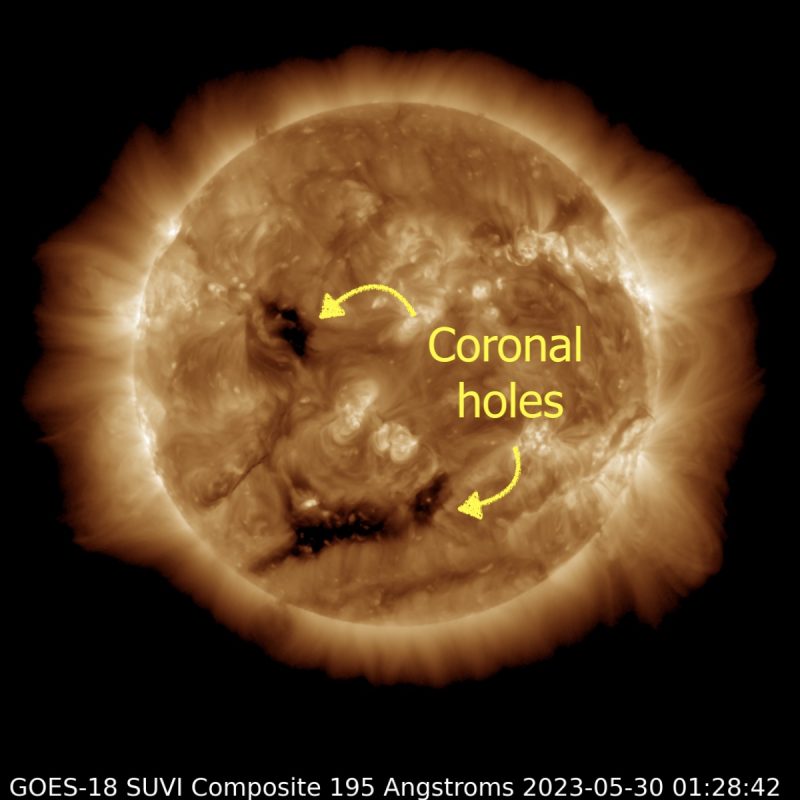
Sun activity for May 29, 2023: The big sunspot region is getting bigger
The sunspots continue to stir. And that big sunspot region – AR3315 – has grown! You could now line up about 10 Earths back-to-back from one end of the sunspot to the other. This means the region is still quite visible from the ground with the proper viewing equipment. Just be sure to protect your eyes. Tips for observing the sun safely here. And, yes, your eclipse glasses are enough to let you see it. Want to get a better look? Switch to solar binoculars (several people at EarthSky’s sun team use these). Overall, sun activity is low now. But there’s always hope for more action. AR3315 has maintained its delta regions (a sign of a potential for increasing flaring). But AR3316 has lost its delta. Finally, keep an eye on the sun’s eastern limb (edge)! Four of the C flares of the past day came from either the northeast or southeast. That’s the side of the sun rotating into view. So some of the regions on the sun’s far side – soon to appear – might provide some sun fun. Stay tuned!
Last 24 hours: Sun activity is low with 11 C flares. The largest event, a C2.3, at 7:15 UTC on May 28, 2023 from a region just over the limb (edge) in the northeast. Today, the sun has seven sunspot regions.

Sun activity for May 28, 2023: A prominence dances as sunspots stir
Today’s top news: Despite only moderate sun activity, the sunspots are stirring. AR3314, AR3315, and AR3316 have all seen growth in size and magnetic complexity over the past day. But what is most exciting is that AR3315 and AR3316 have developed delta regions, indicating stronger chance for M and X flares. The sun didn’t stop there. While the sunspots get ready for action, a spectacular prominence erupted off the southeast limb (edge) midday (around 11:54 UTC) May 27, 2023. Meanwhile, several sunspot regions still gather on the far side of the sun and should start to make themselves known in a few days. Don’t forget to break out your safe solar viewing or eclipse glasses to check out the large sunspots visible from the ground. Just be sure to never, NEVER, look at the sun without the proper eye protection. Tips for observing the sun safely here. Want to get a better look? Switch to solar binoculars (several people at EarthSky’s sun team use these). Excitement is building so stay tuned!
Last 24 hours: Sun activity with moderate with 12 C flares and one M flare. The largest event, an M1, was a C6.2 at 10:20 UTC on May 28, 2023 from AR3312. This created an R1 (minor) radio blackout over Africa. Today, the sun has seven sunspot regions.
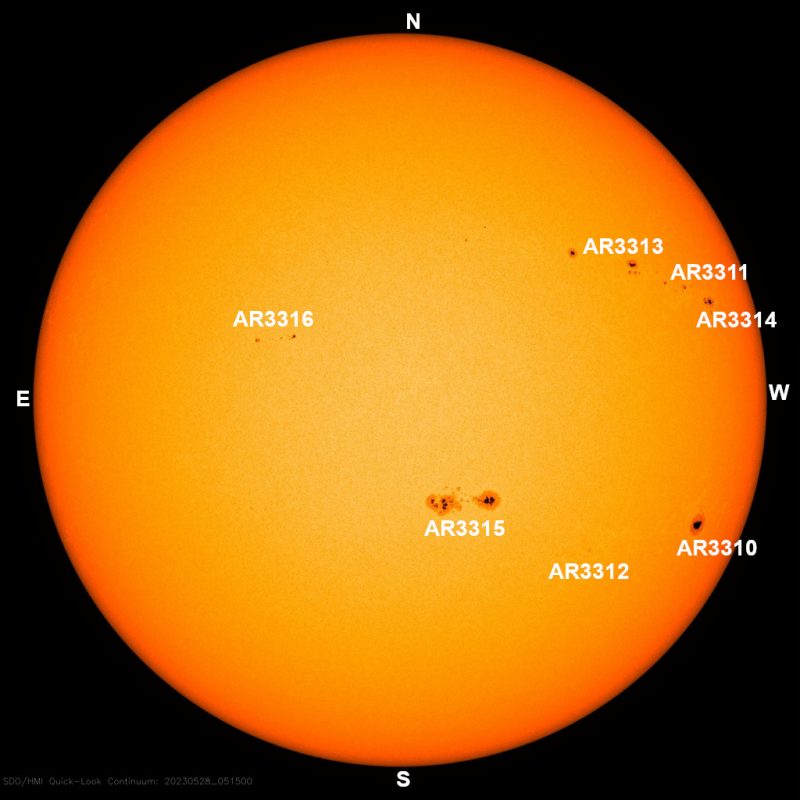
Sun activity for May 27, 2023: We have a new giant sunspot!
Sun activity continues to be relatively calm, with reduced flaring quantity and intensity. But there are some big sunspots on the sun now! AR3310 has been visible through eclipse glasses only (no magnification needed) for several days. And now sunspot AR3315 is also growing, both in size and magnetic complexity. AR3310 will soon be carried out of view by the sun’s rotation. But AR3315 is further to the east on the sun’s Earth-facing side and so will be visible longer. Both spots are must-sees and can be observed without magnification from Earth. Just be sure to never, NEVER, look at the sun without the proper eye protection. Tips for observing the sun safely here. Want to get a better look? Switch to solar binoculars (several people at EarthSky’s sun team use these). So what are NOAA forecasters saying about these two big spots? AR3315 has a delta region – indicating a potential for increasing flaring – that formed in between its intermediate spots. Due to this delta region, the forecasters upped their predictions for X flares in the near future.
Last 24 hours: Sun activity with one M flare and 11 C flares during the past day from 11 UTC yesterday to 11 UTC today. The M flare was an M1.4 at 23:03 UTC on May 26, 2023, from AR3315. The region is now the main flare producer of the period with a total of 10 flares, the M included. An R1 (minor) radio blackout occurred after the M flare affecting an area in the middle of the Pacific Ocean over Hawaii. There’s a newcomer on the northeast quadrant now labeled AR3316. Today, the sun has seven sunspots.
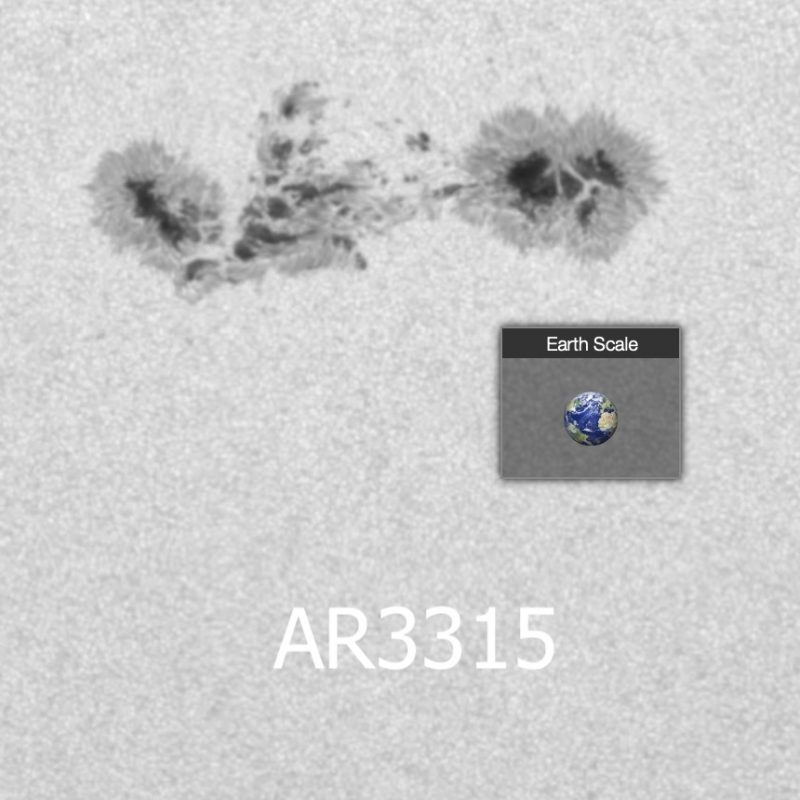

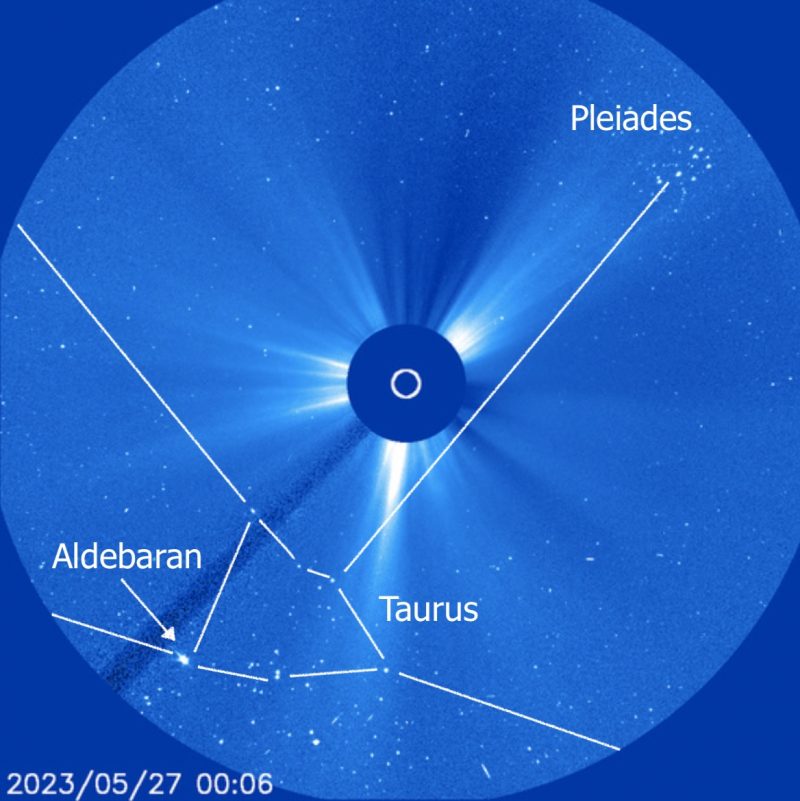
Sun activity for May 26, 2023: Sunspot AR3315 takes the lead
Sun activity has come to a relative calm, with reduced flaring quantity and intensity. Between 11 UTC yesterday and 11 UTC today, only one M flare – an M1.1 – was produced. This M flare came from sunspot region AR3312. But AR3312 wasn’t the day’s leading flare producer. That honor went to sunspot AR3315, which we reported yesterday as having dramatic growth. After much stirring yesterday, the rest of the active regions on the Earth-viewed sun are stable. Meanwhile, the view of the SOHO satellite was visited by brilliant star Aldebaran, the fiery Eye of the Bull in the constellation Taurus. Check it out in LASCO C3 imagery below.
Last 24 hours: Sun activity remains at moderate level, with one faint M flare and 12 C flares produced between 11 UTC yesterday and 11 UTC today. The reduction in flaring production came as AR3311, the lead producer of recent days, lost its delta region and started decaying. The largest flare was an M1.1 by AR3312 at 14:46 UTC on May 25. The leading producer was AR3315, with seven of the 12 C flares. As we reported yesterday, this sunspot has shown rapid growth since its arrival on May 23. It continues to grow, but at a slightly reduced rate. After the M flare, an R1 (minor) radio blackout affected an area over the Atlantic Ocean west of north Africa. The sun currently has six labeled active regions.
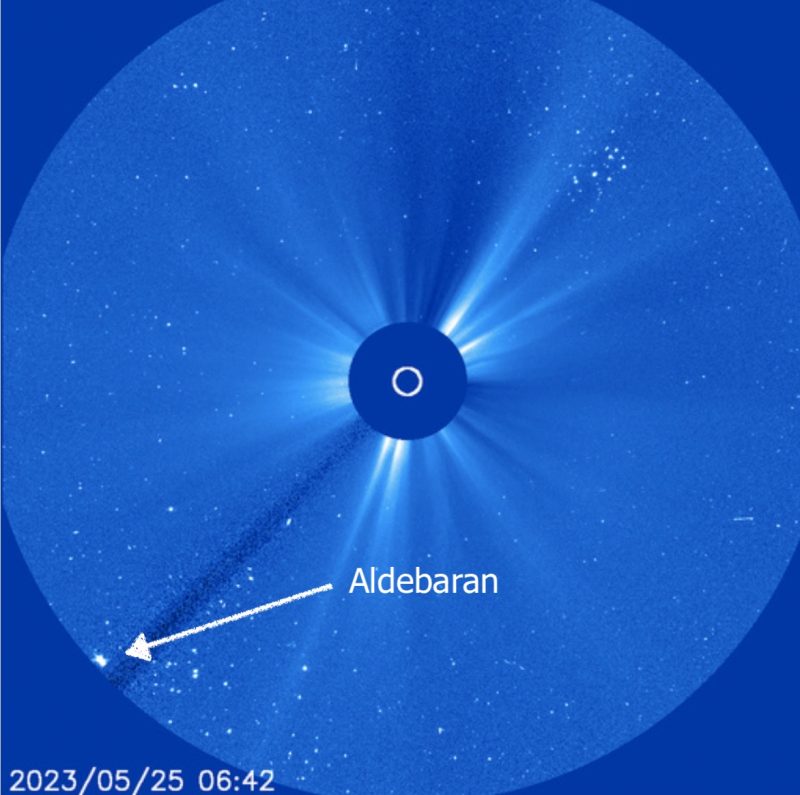
Sun activity for May 25, 2023: Sunspots are stirring all around the sun
Excitement is brewing, with sunspots stirring all around our sun. AR3315, which was barely visible yesterday, has quickly grown in size over the past day. And after merging with AR3311 yesterday, AR3314 has regained its independent identity. AR3311 has lost its delta region, so it now has only a beta-gamma classification, but it still remains the leader in magnetic complexity and flare production. It helped to keep sun activity at moderate levels with the largest of two M flares. It has still not yet given us an X flare, and this loss of complexity makes an X flare less likely, but we can’t count AR3311 out yet. Note that AR3310 is actually larger than AR3311, making it the largest sunspot group, but it is magnetically simple. The less complex a sunspot, the less active it is, so although this single roundish spot looks impressive, it is not that exciting in terms of activity. What is exciting is that AR3310 is visible from here on the ground! Just make sure you only look at the sun with the proper protective eyewear. We are also tracking sunspots that lie on the sun’s far side. The largest sunspot shown there via helioseismology is 4 – 5 days away from rotating into view. And keeping with the sun’s far side, we saw a couple of beautiful prominences that seem to have originated from beyond the southwest limb (edge). Check them out below. You can also view a filament eruption that blasted some ejecta into space at around 16:32 UTC on May 24.
Last 24 hours: Sun activity is moderate today. 17 flares were produced between 11 UTC yesterday and 11 UTC today: two Ms and 15 Cs. The leading producer is sunspot AR3311 which exploded 14 flares, including one of the Ms. This active region has been the most prolific flare producer since it appeared on the Earth-viewed sun on May 18. The largest flare was an M1.9 flare by AR3311. The blast occurred at 17:26 UTC on May 24. The second M flare was an M1.0 at 18:00 UTC by AR3315 on May 24. Both Ms provoked corresponding R1 (minor) radio blackouts, the first affecting an area over the Caribbean and the second an area over Mexico and the south of the United States. With the regained independence of AR3314, the sun currently has six labeled active regions.

Sun activity for May 24, 2023: Far-side sunspots coming our way
The brief lull in solar action continues, with two M flares keeping activity levels at moderate. But there’s excitement if we look behind the curtain! Using helioseismology, which measures vibrations in the sun to give us an image of its far side, we can see that a lot of sunspots are waiting there out of sight. So, as the sun rotates, we could have several new regions arriving soon onto the Earth-facing side. That could include the return of former sunspot region AR3296. We say former because, even if a region rotates all the way around the sun, it gets relabeled when it comes back into view. This is what happened recently when AR3288 returned to the Earth-viewed solar disk – you’ll now know it as AR3310. However, most sunspots decay and disappear before making it all the way around our star. So we can’t know how many of these sunspots will actually come into view. We’ll have to wait and see! By the way, keeping our attention on the far side of our sun, a filament explosion at around 11:24 UTC on May 23 fired a full halo coronal mass ejection (CME) in the opposite direction to Earth. Check out the LASCO C3 imagery below.
Last 24 hours: Sun activity continues at moderate levels, with a total of 18 flares produced between 11 UTC yesterday and 11 UTC today. There were two M flares from sunspot AR3311, the largest being an M3.1 flare at 12:13 UTC on May 23. The rest were C flares. The lead flare producer was AR3311 with 14 flares, the two Ms included. This active region is currently the largest sunspot on the Earth-facing side of our star, and it has retained its beta-gamma-delta magnetic configuration. This means it has the potential for more M and even X flares. For now it is remaining productive, but is mostly releasing Cs. It is now reaching a geoeffective position, so there are good chances that any coronal mass ejections (CMEs) would be Earth-directed. We’ll keep a close eye on this region. An R1 (minor) radio blackout associated with the first of AR3311’s two M flares was registered affecting an area over northeast Africa. The sun currently has five labeled active regions on its Earth-facing side. Note that AR3314 has merged into AR3311, after AR3314 lost its main spot and was reduced to mostly plage. Now the full area is labeled AR3311, including what was once AR3314.
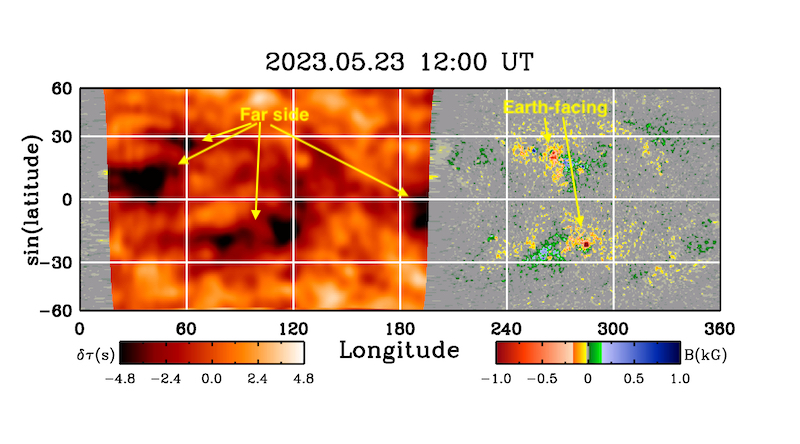

Sun activity for May 23, 2023: A classic lightbulb CME
After the surprising geomagnetic storm at Earth yesterday – and a couple of active days on the sun – both the sun and Earth’s geomagnetic field have returned to calmer conditions. But there’s always something to see on our star! A filament eruption just just over the sun’s northwest limb, near the pole, produced what sun experts consider to be a “classic” lightbulb-shaped coronal mass ejection (CME). The eruption occured at around 12:40 UTC on May 22. See the lightbulb-shaped CME shooting northward on the sun in the image at top? These sorts of CMEs were first seen in the early days of the NASA-ESA SOHO spacecraft, which launched in 1995. You’ll find a still image of a lightbulb-shaped CME here. It’s easier in the still image to see that a lightbulb-shaped CME shows the core of the CME, surrounded by a cavity, and then bordered by the CME’s leading edge.
Last 24 hours: Sun activity is moderate. The sun produced 12 flares, including an M1.9 flare, which was the largest of the past day. So that’s 11 Cs and an M from 11 UTC yesterday to 11 UTC today. The lead flare producer of the past day was sunspot AR3311, blasting eight out of the 12 flares. This region also showed some growth, regaining its delta region, and now showing a beta-gamma-delta magnetic configuration (indicating a greater potential for M and even X flares). AR3311 is the largest and most complex active region on the sun at present. But AR3311 didn’t produce the M1.9 flare. The flare came from sunspot region AR3312 at 13:37 UTC on May 22. A narrow CME with a possible earthward component was associated with the M flare. Shortly after this solar explosion, an R1 (minor) radio blackout was observed affecting an area over the Atlantic Ocean west of the African coast. The sun currently has six labeled active regions on its Earth-facing side.

Sun activity for May 22, 2023: A surprise geomagnetic storm
Surprise! An unsettled geomagnetic field was expected. But what we got was a geomagnetic storm that jumped back and forth from G1 (minor) and G2 (moderate) levels. The storming rollercoaster started at 20:37 UTC on May 21 and ended at around 3 UTC, early on May 22. Auroras were visible down to northern U.S. states. Did you photograph any aurora? Share your photos with Earthsky.
Last 24 hours: Over the past day, after two days of high activity, sun activity decreased to moderate. The big producer of the past two days – sunspot region AR3311 – lost some of its magnetic complexity, going from beta-gamma-delta to beta-gamma.. And this sunspot region produced the past day’s single M flare, an M2.6. This event happened at 15:49 UTC on May 21, 2023. A subsequent R1 (minor) radio blackout happened over the sun-facing side of Earth. A total of 15 flares occurred over the past day, 14 C flares and the single M flare. Helioseismology shows some new sunspots a few days away so perhaps activity will soon increase if the current regions don’t kick back into gear. Stay tuned! The sun currently has seven labeled active regions on its Earth-facing side.
Sun activity for May 21, 2023: An increase in X flaring?
Sun activity is high with 5 M flares, including an M8.9 from AR3211! The region’s potential for an X flare has increased!
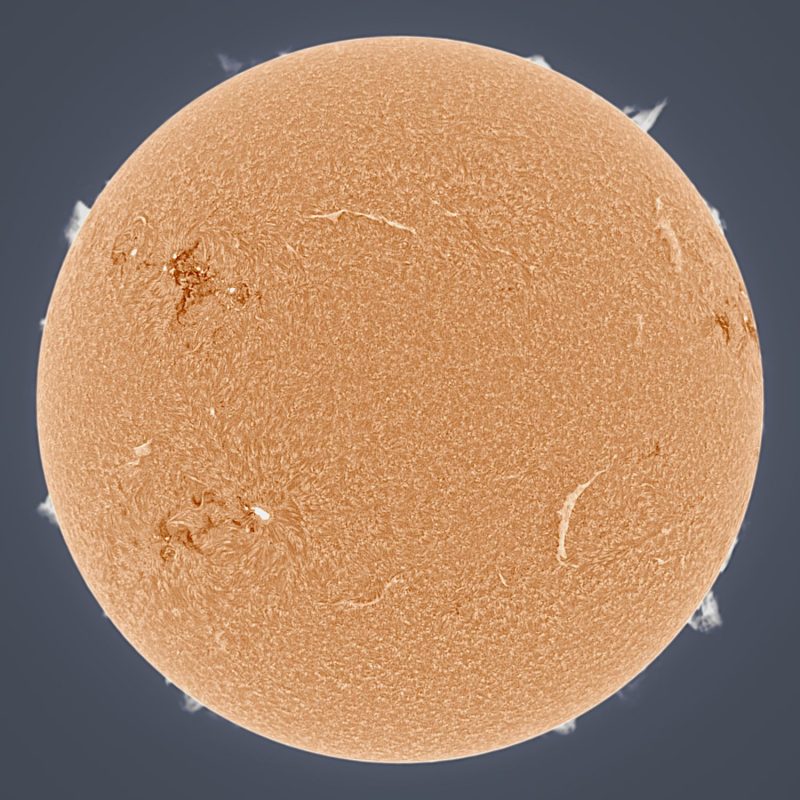 View at EarthSky Community Photos. | Mario Rana in Hampton, Virginia, captured this filtered image on May 21, 2023. Mario wrote: “Hydrogen-alpha image of the sun featuring active region AR3311, and some nice filaments and prominences.” Thank you, Mario!
View at EarthSky Community Photos. | Mario Rana in Hampton, Virginia, captured this filtered image on May 21, 2023. Mario wrote: “Hydrogen-alpha image of the sun featuring active region AR3311, and some nice filaments and prominences.” Thank you, Mario!
Sun activity for May 20, 2023: Active sunspot region keeps on flaring
Excitement continues, with high sun activity. Sunspot region AR3211 became more magnetically complex with a beta-gamma-delta configuration, and more complexity indicates a potential for more flares. And AR3211 did give off five more M flares over the past day. One – an M8.9 on May 20 – was almost an X flare, the strongest category of flare. The chance for more M flares – and even an X flare – has increased with this growth in complexity from AR3211 along with its volley of flaring. None of the flaring have produced any significant coronal mass ejections (CMEs). Geomagnetic activity has calmed. But that might change by May 23 with more coronal hole influence. In the meantime, all eyes are on the sun and AR3211. Will the region give us an X flare? Stay tuned to find out!
Last 24 hours: Sun activity is high with five M flares from sunspot region AR3311. The largest was an M8.9 flare from AR3311 at 12:25 UTC on May 20. Total flare production for the day was 25 flares: five Ms and 20 Cs. AR3311 continues as the lead flare producer. It released 13 flares during the period, including the five M flares. Here’s the breakdown of AR3311’s M flaring (all times in UTC):
M8.9 at 12:25, May 20 (the largest)
M5.7 at 14:54, May 20
M1.2 at 18:57, May 20
M5.2 at 22:52, May 20
M1.4 at 02:18, May 21
R1 (minor) radio blackouts were observed after each M flare over the sun-facing part of Earth. The M8.9 flare produced an R2 (moderate) radio blackout that affected an area over the Atlantic Ocean, Europe and Africa. There is one new sunspot: AR3214, which emerged just to the west of AR3311. The sun currently has eight labeled active regions on its Earth-facing side.
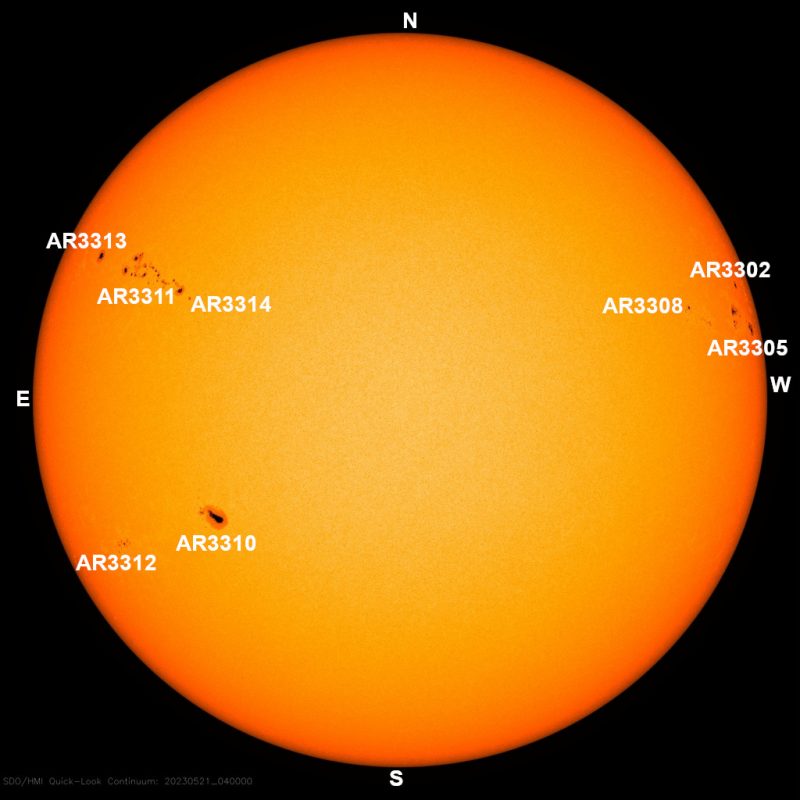
Sun activity for May 19, 2023: BAM, BAM, BAM! A fiesta of M flares
The sunspot region we observed M flaring yesterday, just beyond the sun’s northeast limb, is now fully in sight and flaring like crazy. Now numbered AR3311, it blasted nine M flares in a row over the past day (11 UTC yesterday to 11 UTC today). If not for one isolated C5.2 flare by AR3310, AR3311 would be the only flare producer for the day. Wow. What a region. Due to AR3311’s position on the solar disk, none of the coronal mass ejections (CMEs) produced during these M flares are Earth-directed. But as the sun rotates – carrying this sunspot towards a more geoeffective position – its CME production might bring us some wonderful auroral displays. Stay tuned.
Last 24 hours: Sun activity is high with the production of nine M flares from newly-labeled region AR3311. The largest was an M5.4 flare at 00:48 UTC on May 19. Total flaring production of the day was 22 flares: nine Ms and 13 Cs. All but one flare came from this newcomer region on the northeast limb. Here’s the breakdown of AR3311’s nine M flares (all times in UTC):
M2.2 at 11:47, May 18
M1.9 at 12:13, May 18
M1.6 at 12:49, May 18
M1.1 at 17:51, May 18
M3.9 at 20:23, May 18
M4.5 at 21:05, May 18
M5.4 at 0:48, May 19 (the largest)
M1.6 at 3:12, May 19
M2.5 at 5:00, May 19
What a day!
R1 (minor) radio blackouts were observed after each M flare over the sun-facing part of Earth. The M5.4 flare produced an R2 (moderate) radio blackout that affected an area over the Pacific Ocean. Today, the sun has seven labeled active regions on its Earth-facing side.

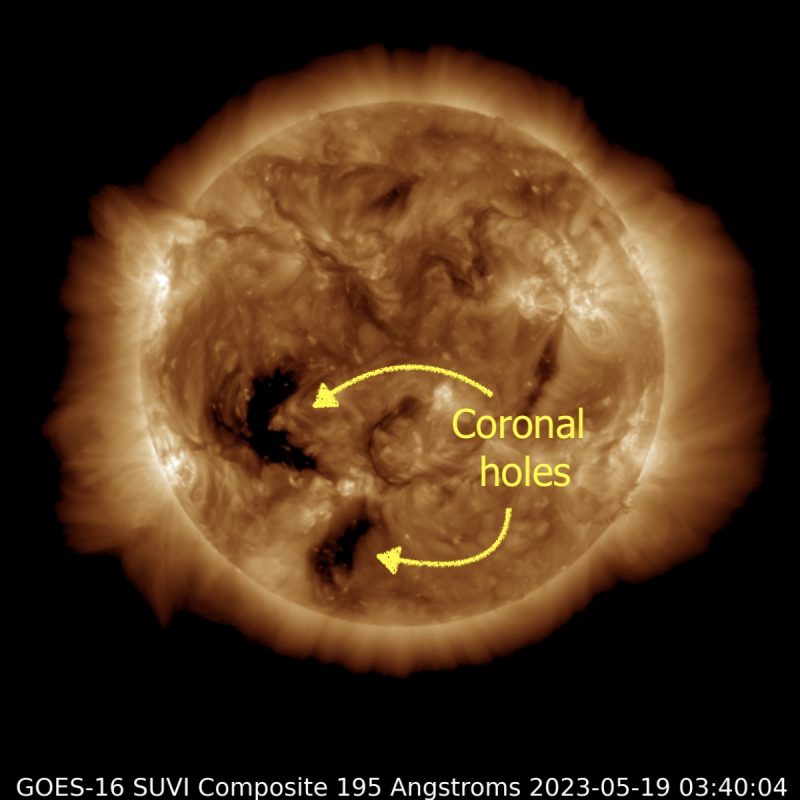
Sun activity for May 18, 2023: Action ramping up on the eastern limb
The east is now the area to watch on our sun. An active region beyond the northeast solar horizon was the past day’s top flare producer (11 UTC yesterday to 11 UTC today). It produced two back to back M flares and an array of Cs. The first, an M1.0, blasted this morning at 06:26 UTC, and the second, an M1.2 flare, was fired at 06:55 UTC. With old sunspot region AR3288 rotating back into view on the southeast limb (now re-numbered as AR3310), this gives us two regions in the east ramping up the action. On top of that, two large eastern coronal holes emerged close to the equator. Their high-speed solar wind will soon reach Earth, so geomagnetic disturbance is on its way! Not all the action is in the east, though. A beautiful, enormous prominence danced off the northwest limb around 3:32 UTC today, May 18 – check it out below.
Last 24 hours: Sun activity is moderate. There were 16 flares produced during the period (from 11 UTC yesterday to 11 UTC today): 2 Ms and 14 Cs. The largest was an M1.2 flare at 06:55 UTC on May 18 from a region behind the northeast limb (edge). The blast caused an R1 (minor) radio blackout that affected an area over India. AR3288 has made its long-awaited return to the Earth-viewed sun after days of producing jets, active prominences, and yesterday’s almost-X flare from behind the solar horizon. Now it has rotated fully into sight, it has been re-labeled AR3310 for its second trip across the Earth-viewed solar disk. AR3209 has emerged from nowhere in the middle of the solar southwest quadrant. Today the sun has seven labeled active regions on its Earth-facing side.
Sun activity for May 17, 2023: Active sunspot region is back
Yes! The old M flare producer we were talking about yesterday has returned to the Earth-viewed sun, bringing an M flare with it. Before rotating fully into view on the southeast limb, old friend AR3288 gave us an M9.6 flare at 16:43 UTC on May 16. The blast registered as an M, but since it happened behind the limb (edge) it was actually almost certainly an X flare! The explosion produced a coronal mass ejection (CME), but it is not Earth-bound. Shortly after the flare, an R2 (moderate) radio blackout affected an area over the Caribbean. Meanwhile, on the southwest limb (edge), LASCO C2 observed an impressive CME at around 17:36 UTC on May 16. The eruption happened beyond the southwest limb, so the CME is not Earth-oriented.
Last 24 hours: Sun activity is high, with an M9.6 flare at 16:43 UTC on May 16. It was the largest event during the past day (11 UTC yesterday to 11 UTC today). Flaring production of the period was 13 flares: the M, plus 12 C flares. Nine flares, including the M9.6, came from a region just behind the southeast limb (edge). It is probably the region formerly known as AR3288, returning back into our view having passed across the far side of the sun. We have to wait a few more days until it receives a new number for its next trip across the Earth-facing sun, and before we can determine the full extent of the region. At present it appears to be a fairly large sunspot. The sun currently has seven labeled active regions on its Earth-facing side.
Sun activity for May 16, 2023: Possible return for old M flare producer
Low sun activity continues, with only faint C flares produced over the past day (11 UTC yesterday to 11 UTC today). But a long-lasting prominence is dancing off the sun’s southwest limb, indicating an active sunspot region just over the edge. This might be associated with our old M-flare producer, AR3288. Perhaps it survived its journey across the far side of the sun – the side we don’t see from Earth – and will soon rotate back into view. Finally, don’t miss today’s LASCO C3 imagery, below, which features a visit from the famous asterism Pleiades!
Last 24 hours: Sun activity is low. During the past day (11 UTC yesterday to 11 UTC today), we had only six C flares. The largest was a C1.9 flare at 14:56 UTC on May 15, which came from sunspot region AR3306. Region AR3307 emerged in the southeast near the equator. AR3305 was the most active region, with three C flares. AR3305 is showing some magnetic complexity (beta-gamma classification) while the rest are simple regions. The sun currently has six labeled active regions on the sun’s Earth-facing side.
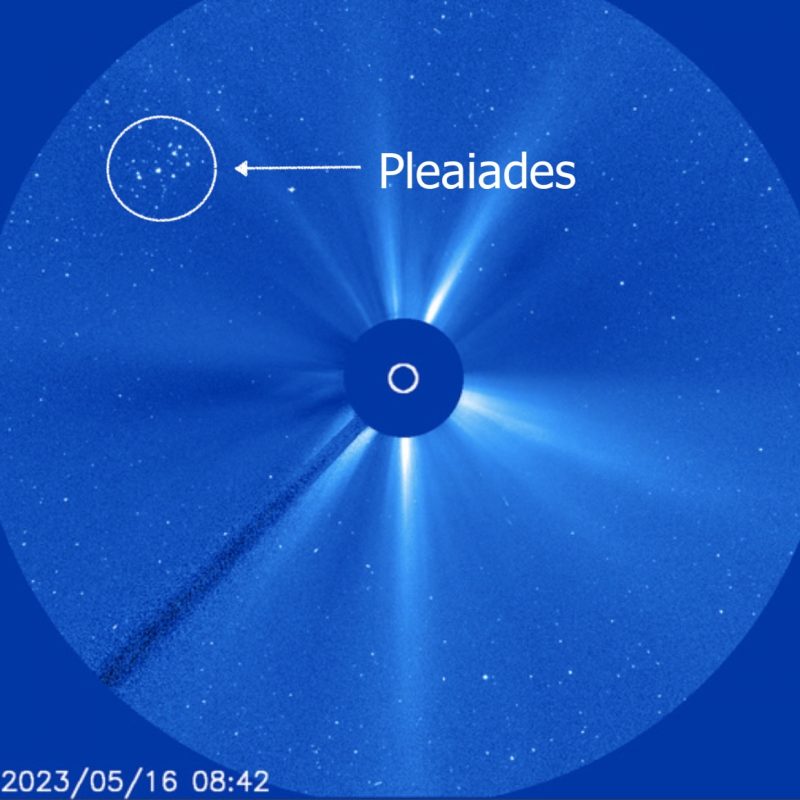
Sun activity for May 15, 2023: A multi-wavelength view of our star
Sun activity is low today. In the past 24 hours, there’ve been only small C flares. But you wouldn’t know it looking at our star. When we observe the sun in visible light, we see sunspots. But – in order to see at a variety of wavelengths – in 2010, NASA launched a solar telescope into space onboard the Solar Dynamics Observatory (SDO). And, becasuse SDO is above Earth’s atmosphere, scientists can observe the sun with types of light that Earth’s atmosphere blocks. These are the more energetic wavelengths of light, extreme-ultraviolet, showing a much more dynamic and exciting sun. So SDO has forever changed our understanding of the sun, by providing images of it at 10 different wavelengths every 12 seconds.
Last 24 hours: Sun activity is low with 11 C flares produced over the past day (11 UTC yesterday to 11 UTC today). The largest was a C3.4 flare at 00:46 UTC on May 15 from sunspot region AR3306. The sun currently has five labeled active regions on the Earth-facing side.
Sun activity for May 14, 2023: It’s a quiet day on the sun
It’s all relative. This is a common phrase used to point out that something should be considered with respect to something else, not just on its own. That would apply for what quiet means on the sun today. Today is a quiet day with low sun activity. There are 12 C flares and no significant coronal mass ejections (CMEs). But just two years ago today, a quiet sun meant no C flares and only four B flares (10 times smaller than a C flare). There were no CMEs. After having several Earth-directed CMEs and several M flares over the last week, today looks relatively quiet. This is all an indication that we are fast approaching solar maximum. These periods of “quiet” will be shorter and less frequent over the next couple of years. We wait for what the sun has to bring next. Stay tuned for more excitement.
Last 24 hours: Sun activity is low with 12 C flares produced over the past day (11 UTC yesterday to 11 UTC today). The largest was a C7 flare at 9:07 UTC by sunspot region AR3296. The sun currently has eight labeled active regions on the Earth-facing side.
Sun activity for May 13, 2023: Departing sunspot delivers a farewell eruption
Sunspot region AR3296 has been nearing the northwest solar limb (edge). But, before being carried out of view by the sun’s rotation, this active region delivered a breathtaking prominence eruption. The blast produced double C flares. The first was a C5.5 flare, at 23:48 UTC on May 12. And the second was a C9.1, at 00:45 UTC on May 13. This second flare was almost an M flare. AR3296’s transit across the Earth-facing side of the sun – over the past week or so – has been exciting! This sunspot region has the odd anti-Hale polarity. That is, its north and south poles are opposite the other sunspots in its hemisphere. It produced 11 M and 38 C flares during the time we were able to view it. It also carried a delta region – indicating a potential for more powerful flares, like M or X flares – more than once. The only thing it didn’t bring us was an actual X flare. We haven’t seen an X flare since March 29, 2023.
Last 24 hours: Sun activity is moderate, with 14 C flares produced over the past day (11 UTC yesterday to 11 UTC today). The largest was a C9.1 flare at 00:45 UTC by AR3296. The region produced six out the 14 C flares. The sun currently has eight labeled active regions on the Earth-facing side.
Sun activity for May 12, 2023: A huge sunspot could arrive soon
Scientists have spied a huge sunspot on the back side of the sun, using helioseismology with data from the Solar Dynamics Observatory (SDO). The sun’s rotation should carry the spot onto the Earth-facing solar disk in five to six days. So now we wait to see if the region lasts that long! Closer to home, solar wind parameters have indicated the arrival earlier today of the coronal mass ejection (CME) from May 9. While up to G3 (strong) geomagnetic storming was forecast, the disturbance only agitated the geomagnetic field to active levels (Kp = 4) early this morning, May 12. This event has proven difficult to analyze due to its complexity. But there’s still a chance for G1 (minor) to G2 (moderate) geomagnetic storms later today. Finally, did you see our imagery yesterday of a beautiful, huge prominence? It hurled a CME into space at 7 UTC on May 11. It’s visible in LASCO C3 imagery below. The blast was not Earth-directed.
Last 24 hours: Sun activity is moderate, with one M flare and seven C flares produced over the past day (11 UTC yesterday to 11 UTC today). The largest was an M1.8 flare from AR3294 at 18:29 UTC on May 12. The flare produced an R1 (minor) radio blackout over Mexico. The sun currently has eight labeled active regions on its Earth-facing side.

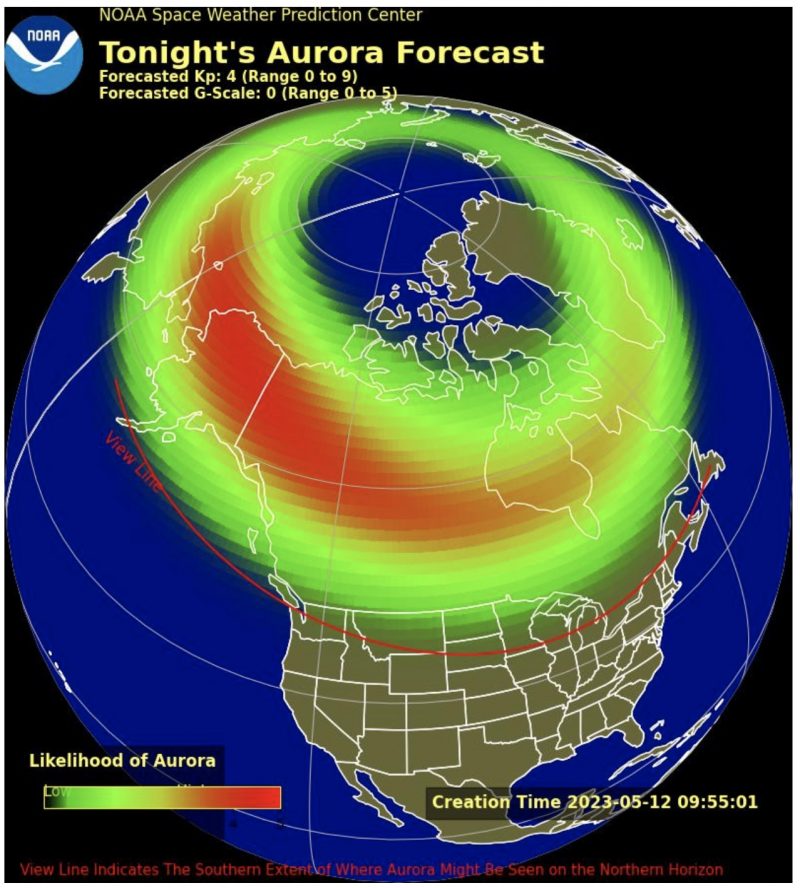
Sun activity for May 11, 2023: CME coming our way, G3 storms expected
It has been confirmed: the full halo coronal mass ejection (CME) produced by an M4.2 flare on May 9 is coming our way. Its arrival is expected around 12 UTC today, May 11. Geomagnetic storming may reach G3 (strong) levels at around 15 UTC today, extending into early May 12. This could mean auroral displays for northern latitudes as far south as New York State and Illinois in the US. Aurora watchers, polish your lenses! And please share your beautiful photos with us. Meanwhile on the sun itself, AR3296 has showed some decay and has lost its delta region, but it still retains its anti-Hale reverse polarity and moderate magnetic complexity. It will soon rotate out of view over the west limb (edge). The sun is also displaying three breathtaking closed loop prominences. The first appeared on the northeast limb (edge) at 18 UTC on May 10, the second on the northwest limb at around 2 UTC on May 11, and a third at 7 UTC, May 11.
Last 24 hours: Sun activity is moderate. There were 15 flares produced between 11 UTC yesterday and 11 UTC today: 13 Cs and two M flares. Both of the Ms were M2.2 flares. The first came from sunspot AR3296 at 14:21 UTC on May 10, and the second came from AR3294 at 9:01 UTC on May 11. Both caused R1 (minor) radio blackouts. The first affected an area over Mexico and South of US, and the second an area over Saudi Arabia. The sun currently has seven labeled active regions on its Earth-facing side.

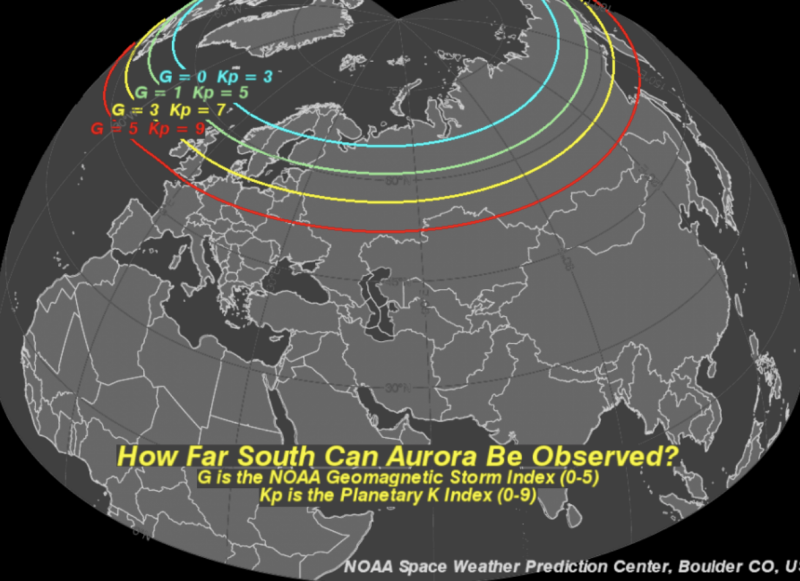
Sun activity for May 10, 2023: CME strikes Earth as more leave the sun
The awaited coronal mass ejection (CME) from May 7 struck Earth late last night (23:59 UTC on May 9). A G1 (minor) geomagnetic storm followed. NOAA forecasters anticipate up to a G2 (moderate) geomagnetic storm today, continuing into the early hours of May 11. This may bring auroral displays to the northern U.S. – good luck, aurora-chasers! Meanwhile, the sun continues to fire off CMEs. We saw a full halo CME from an M4.2 flare by AR3296. This event produced a solar particle burst, which was accelerated by the CME shock wave. More intense flaring from AR3296 could be incoming, as it has now developed a delta region. This, combined with its anti-Hale nature, gives a strong indication for more activity, including possible X flaring. Stay tuned to see if AR3296 lives up to its potential.
Last 24 hours: Sun activity is high, with M4.2 and M5 flares. AR3296 was the main flare producer with both of the two M flares and 9 of the 10 C flares. The largest event, an M5 at 20:52 UTC on May 9, followed the M4.2 flare which was released at 18:20 UTC. As mentioned above, the M4.2 was the more notable event because it brought a full halo coronal mass ejection (CME) and a solar particle event accelerated by the CME shock wave. The sun currently has nine labeled active regions, including the addition of four newly-labeled newcomers: AR3300, AR3301, AR3302, and AR3203.
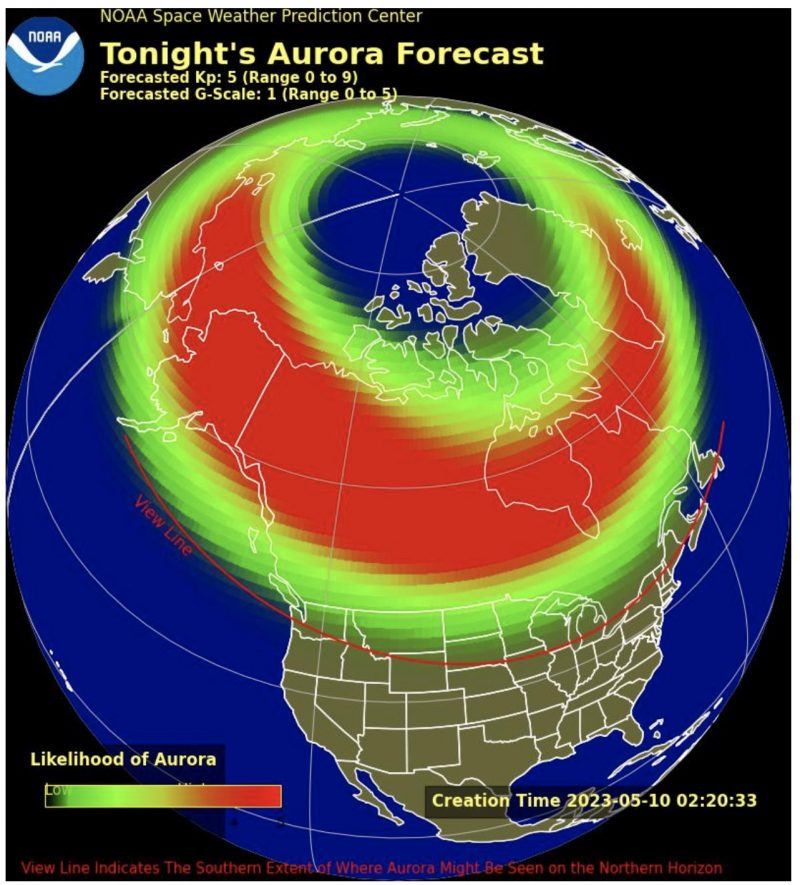
Sun activity for May 9, 2023: All eyes are on sunspot AR3296
Sunspot AR3296 has single-handedly brought sun activity to a high level, with M6.5, M2.3, M1.4 and M1.2 flares in the past day. The region does not currently have a delta region, that is, a region indicating a likelihood for M or X flares. But it still carries its anti-Hale feature, a reversed magnetic polarity (read about Hale’s Law here). And it has some magnetic complexity overall. Plus, it has increased in activity over the past 24 hours! It produced the four M flares, plus 16 of a total of 19 C flares observed over the past day. All of this gives us a force to reckon with.
Last 24 hours: Sun activity is high due to four M flares, including one flare stronger than M5. This largest event was an M6.5 from AR3296 at 3:54 UTC on May 9, 2023. The other M flares were, an M2.3 at 20:25 UTC on May 8, an M1.2 at 6:13 UTC on May 9, and an M1.4 at 10:20 UTC on May 9. All four M flares came from sunspot region AR3296. Each M flare produced its correspondent radio blackout and the largest flare produced an R2 (moderate) radio blackout affecting an area over Taiwan and the Philippine Sea. AR3296 produced 20 of the 23 flares observed in the past day (19 C flares and 4 M flares). The sun has five Earth-facing sunspot regions today.
Sun activity for May 8, 2023: Storming has started. More CMEs on the way
Sun activity is moderate, and there’s been activity both on the sun and at Earth. A coronal mass ejection (CME) struck Earth yesterday, causing geomagnetic storming. It struck at around 15:50 UTC on May 7 and caused a minor (G1) storm as May 8 began. It wasn’t the expected G2 storm. But it’s not over yet! We’re currently awaiting more CMEs at Earth and more geomagnetic activity over the next two to three days. And – as Earth was being buffeted late yesterday and early today by the CME (which is a large expulsions of solar plasma and magnetic fields from the sun) – the sun itself was getting busy with a long-duration M1.6 flare from AR3296 … and another CME directed our way. We await further analysis of the event. But all signs point to the possibility that the next few days will be exciting for aurora-watchers, here on Earth. Plus! The excitement on the sun might not be over. Both AR3296 and AR3297 have developed delta regions – a sign of more activity to come. Clear skies to all the aurora-watchers. Visit this post again tomorrow, for more fun sun news!
Last 24 hours: Sun activity is moderate due to two M flares and 10 C flares. The largest event was an M1.6/ M1.5 flare from AR3296 at 22:53 UTC on May 7, 2023. The other M flare, an M1.5 – and eight of the C flares – were from AR3296. The M flares registered as two events, but they were part of a single long-duration event. Long-duration events are typically associated with coronal mass ejections (CMEs). This long-duration event has an associated halo-CME, meaning that it appears to be heading directly for Earth. The sun has five Earth-facing sunspot regions.
Sun activity for May 7, 2023: Aurora alert! 3 days of activity ahead
Sun activity is low. But fun is expected here on Earth. Due to a pair of coronal holes and a volley of coronal mass ejections (CMEs) from May 4 to May 5, a significant increase in geomagnetic storming is expected over the next three days. A moderate (G2) storm should start today, May 7, then a severe (G3) storm on May 8, followed by a minor (G1) storm on May 9, 2023. These activity levels should bring auroral displays to northern Europe, Alaska, Canada, and northern US states. Auroras might also be in the forecast for New Zealand and Tasmania. Wishing you clear skies and lots of luck, aurora-watchers! Stay tuned for more sun news.
Last 24 hours: Sun activity is low due to six C flares. The largest event was a C4.7 flare from AR3299 at 21:42 UTC on May 6, 2023. The sun has five Earth-facing sunspot regions.
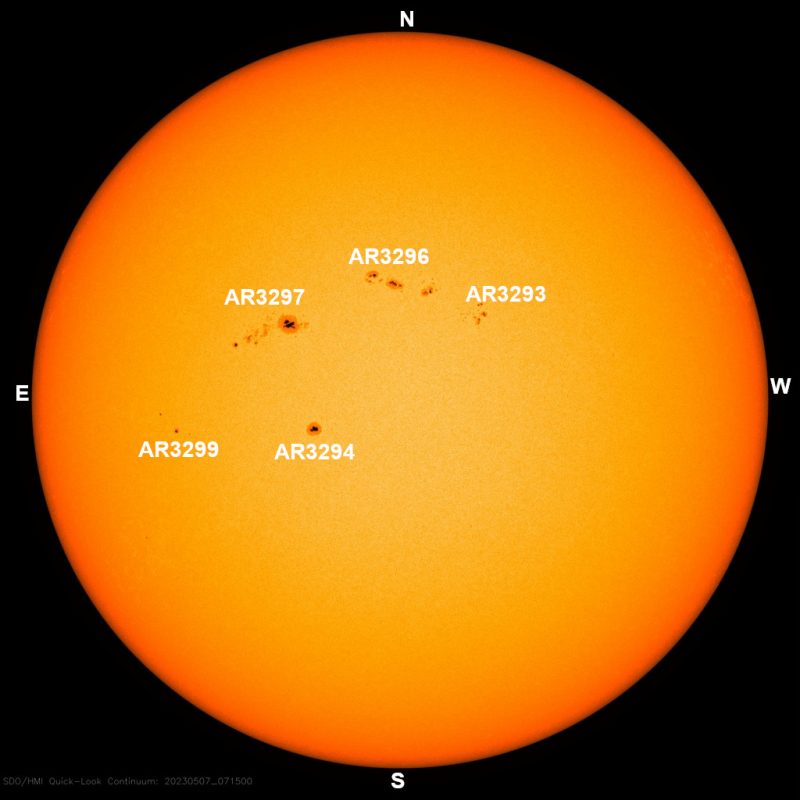
Sun activity for May 6, 2023: Geomagnetic storms, with more on the way
The early arrival of a coronal mass ejection (CME) – combined with fast solar wind – triggered a G1 (minor) and a G2 (moderate) geomagnetic storm. This caused auroral displays in Canada last night, and at least two northern-tier U.S. states, even with the light of a full moon. The G1 and G2 thresholds were reached at 2:53 UTC and 4:50 UTC respectively on May 6. Did you see the auroras? If not, there’s more geomagnetic storming predicted for tonight. Today’s moderate sun activity produced a couple of CMEs, indicating an Earth-directed component arriving on May 8, 2023. Share your pictures with the Earthsky community. And stay tuned for what’s next.
Last 24 hours: Sun activity is moderate due to an M1.2 flare from AR3296 at 15:31 UTC on May 5, 2023. But, almost unbelievably, active region AR3288 – now out of sight on the Earth-viewed solar disk – is still flaring at us from far behind the solar horizon. It blasted a C9.8 flare at 22:27 UTC on May 5, 2023. It was almost an M flare, there are good chances it would have appeared as a much-larger blast, if anyone had been on that side of the sun to see it. Overall, the Earth-viewed side of the sun produced five C flares and one M flare. The sun currently has five Earth-facing labeled sunspot regions.
Sun activity for May 5, 2023: The Sun King sheds its crown
The image below shows a large filament – called a polar crown filament – that exploded on the north pole of our sun yesterday. The LASCO C2 and C3 instruments on the SOHO spacecraft registered the ejecta at around 13 UTC on May 4, 2023. The plasma was ejected during the event and, momentarily, the prominence formed a crown-like halo. Then our star, the Sun King, shed its crown as the filament erupted into space. Nearly coincidentally a halo coronal mass ejection (CME) occurred. Preliminary analysis found it a separate event coming from the far side of the sun, the side we don’t see. So the CME isn’t Earth-directed. But all of this CME activity is very apparent when we observe the sun using the artificial eclipses created by the LASCO coronagraph telescopes aboard the SOHO spacecraft. Sunspot region AR3296 has retained its reversed magnetic polarity compared to the regions surrounding it (see yesterday’s entry). It has kept sun activity at moderate levels by releasing an M2.1 flare with a filament eruption. AR3293 continues with its delta magnetic configuration (an indication of possible strong flares to come) and AR3288 – even from the far side – continues blasting C flares, providing beautiful prominences on the sun’s southwest limb (edge). Stay with us for more sun news.
Last 24 hours: Sun activity is moderate. There were one M and 13 C flares during the past day (11 UTC yesterday to 11 UTC today). Even from the far side, at the very edge of the southwest limb, active region AR3288 was the lead producer of the day with nine C-class flares. The largest flare of the day was the M2.1 blasted at 08:01 UTC on May 5, 2023. It produced a R1 radio blackout over the Arabian Sea. The sun currently has seven Earth-facing labeled sunspot regions.
Sun activity for May 4, 2023: A mixed-up sunspot
As the image below shows, an exciting complex of sunspot regions is appearing in the sun’s northeast quadrant. While sun activity has calmed a bit since yesterday, we are still at moderate levels because of M flares from two of these spots: AR3293 (on May 3) and AR3296 (at the time of this writing, 11 UTC on May 4). One interesting thing to note is that AR3296, which produced an M3.9 flare, appears to have a reversed magnetic polarity compared to the regions surrounding it. The sunspot group appears to be violating Hale’s law, which says sunspots in a single solar hemisphere will have the same polarity as other spots in that hemisphere. Sunspot polarity will be opposite in the opposite hemisphere, by the way, at any given time. And sunspot polarity in the sun’s two hemispheres will reverse with each solar cycle. So! Will the mixed-up polarity of AR3296 interact with other nearby sunspot groups to produce more activity? We’ll have to wait and see.
Last 24 hours: There were 3 M and 16 C flares during the past day (11 UTC yesterday to 11 UTC today). AR3293 and the new region, AR3296, were the leading flare producers. AR3293 produced an M1.7 at 12:23 UTC and an M2.2 at 13:43 UTC on May 3. AR3296 produced the largest event, an M3.9, at 8:05 UTC on May 4. All three M flares produced R1 radio blackouts over the sun-facing side of Earth. The sun currently has seven Earth-facing numbered sunspot regions.
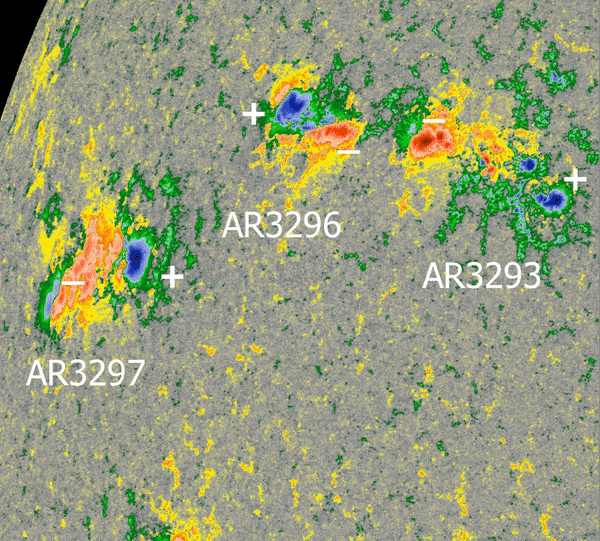
Sun activity for May 3, 2023: Activity is on the rise!
Yesterday’s M7.1 flare producer was sunspot region AR3288. Now AR3288 is being carried out of view in the southwest by the sun’s rotation. And sunspot region AR3293 – in the northeast – has taken over as the activity leader. And what activity! AR3293 popped off three back-to-back M flares today, by the time of this writing (11 UTC, May 3). It released an M4.3, then an M3.1, followed by an M7.1. This trio of blasts means that – as AR3288 did before it – AR3293 is living up to the potential of its delta region (delta regions often produce the most intense solar flares). As AR3288 and its partner AR3285 rotate out of view in the southwest, AR3293 keeps up the momentum in the northeast and is joined by three new regions: AR3294, AR3296, and AR3297. Will there be more to come? Will AR3293 give us an X flare? Stay tuned for more sun news, as we look for what’s next from our star!
Last 24 hours: There were three M and 14 C flares during the past day (11 UTC yesterday to 11 UTC today). AR3288 was the leading flare producer with 10 C flares, but the largest event – an M7.1 – came from AR3293 at 10:45 UTC on May 3. An R2 (minor) radio blackout occurred over Africa. The other M flares came just before the M7.1, all from AR3293. These eruptions were back-to-back; first came an M4.3 at 9:15 UTC, then an M3.1 at 10:14 UTC, May 3. There are currently eight labeled active regions on the Earth-viewed side of our sun.
Sun activity for May 2, 2023: High, with an M7.1 flare
True to its potential, sunspot region AR3288 released an M7.1 flare, bringing sun activity levels to high over the past day. Note the intensity of the flare. It nearly fell into the X flare category, which describes the strongest flares. Sunspot region AR3293 has also tried to keep up, with a barrage of C flares. Like AR3288, AR3293 now has its own delta region. Delta sunspots produce the most intense solar flares. So, though not quite as complex and large as AR3288, AR3293 now joins AR3288 as regions with the potential for more large M and X flare activity. The explosion releasing the M7.1 flare also had a filament eruption. But the material failed to leave the sun, so there was no visible CME associated with the event. Now we wait to see if either region will bring any additional action. Stay tuned!
Last 24 hours: There were 19 flares during the past day (11 UTC yesterday to 11 UTC today), mostly from AR3288 and AR3293. All of the flares were C flares, except for the largest event of the period: the M7.1 from AR3288 at 13:02 UTC, May 1. Shortly after the M flare, an R2 (moderate) radio blackout affected an area over Africa’s northeast coast. The sun has six labeled active regions today.
Sun activity for May 1, 2023: On the rise
A new sunspot region, AR3293, has rotated into view on the sun’s northeast limb. The region erupted with an M2.4 flare, and region AR3288 followed shortly thereafter with an M1.1. Together, these two M flares have raised sun activity to moderate levels. AR3288 still contains its delta region, a possible indication of more strong flaring to come. AR3293 is not as magnetically complex; however, its magnetic complexity is more difficult to determine, due to its location on the edge of the solar disk. We’ll have to wait for it to rotate more into view. Maybe there are larger flares to come. Stay tuned!
Last 24 hours: The most active sunspot region is AR3293. It produced most of the 15 flares (13 C and 2 M) during the past day. And it produced the past day’s largest event, an M2.4 at 19:56 UTC on April 30, 2023. AR3288 produced the other M flare, an M1.1 at 00:55 UTC on May 1, 2023. The sun has six labeled active regions today.
Bottom line: Sun activity archive for May 2023. A daily record of flaring, and other sorts of activity, on our local star.











